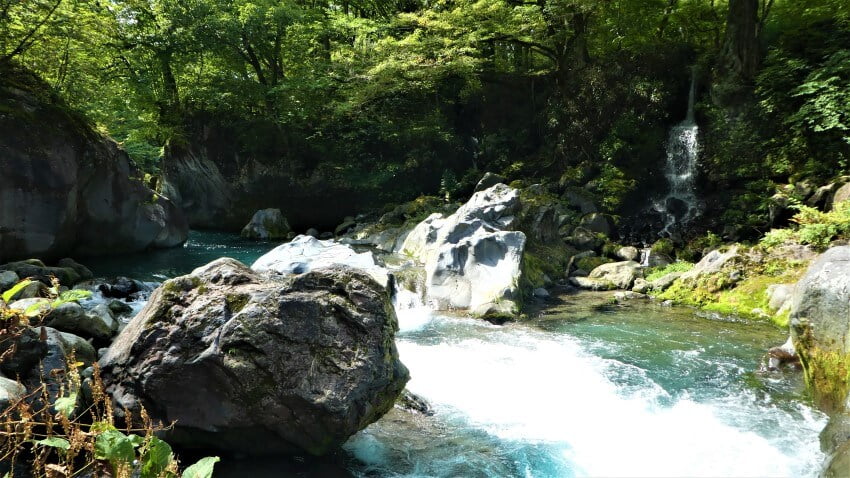Count them! Once in a while one disappears and you’ll never guess the number of statues! 70 you say? Or 71? Start again, but you’ll never know the answer…
Nikko National Park is known for its Unesco World Heritage Site with a number of important temples and shrines. And, of course, you can do some great hikes here that will keep you busy all day. But if you’re looking for a short walk with a bit of mystery, head to the Kanmangafuchi Abyss (憾満ヶ淵). This is a 2-hour walk along the Daiya River near the world-famous temples of Nikko. But that walk might be longer if you start counting the red-clad statues…
What is the story behind these ‘disappearing statues’? And what is the meaning of these little men you see all over Japan? Read all about the mystery of the Kanmangafuchi Abyss here…
Planning a trip to Nikko National Park in Japan? Here you will find your travel guide to discover this beautiful park in Japan

Start of the Kanmangafuchi Abyss at the Shinkyo Bridge?
Officially the Shinkyo bridge is not the start of Kanmangafuchi Abyss, but of the Futarasan shrine. But if you walk from the station towards the temples you can’t miss this famous bridge at all.
This is where the famous monk Shodo Shonin (735-817) crossed the river in the 8th century A.D. with the help of two snakes that formed a bridge and founded a number of temples. In 1636 it was decided to build a bridge here to honour the monk. However, the current Shinkyo bridge dates back to 1907, when it was completely wiped out after a major flood. Against payment it is possible to walk over the bridge. Or you can take a beautiful picture of this iconic wooden monument from the car bridge.
If you turn left after the bridge and follow the river you come to the place where the great mystery is waiting for you….

Kanmangafuchi Abyss and 70 mysterious statues?
Once you cross the river, you seem to have entered another world. In any case, a peaceful world, because not many people come here. 7000 years ago, this gorge was created when Mount Nantai erupted. It was also the last time an eruption took place of the 2484-metre high volcano.
From the beginning of the Kanmangafuchi Abyss, you come across mysterious statues. Are you going to count them? Is the story really true? Feel free to leave a comment below how many statues you counted during the walk. The reason they disappear is pretty simple. It is in the nature of the Bake Jizo (Spirit Jizo) or Narabi Jizo (Jizo in a row). A Jizo is a Bodhisattva who takes care of travellers and is the protector of children. And a Bodhisattva is an enlightened being who would like to become a Buddha, but puts it off to help living people on earth.
Another interesting sight in Nikko National Park is the Kegon Falls. But this beautiful waterfall also has a dark side. Read all about it in the article Kegon Falls | Why 200 people committed suicide in Nikko?


What is the meaning of the Jizo Statues?
So in Buddhism, Jizo is an important Bodhisattva. The story goes that all young children go to Sai-no-kawara after their death. In the underworld this is the dried-up bed of the river of souls. Because they have little experience (karma) they have to build little towers of stones. Each tower represents a prayer. But every night the oni, the devils, come and knock these towers down. The young souls have to start all over again.
But then Jizo comes to their rescue. He wanders around and hides the children in his red bibs. They are now in good hands with Jizo. But why the red bibs? The colour red probably refers to earlier times. An old tradition in the Asuka period (522-645AD) was that children with diseases like chicken pox had to wear red bibs to distinguish them from other children. But red is also seen as the colour that offers protection and security.


Tip: In Nikko I stayed at Nikko Guesthouse Sumica. This hostel is located near the two train stations. The owners are very nice and for a bunkbed I paid around €17 euros. The only disadvantage is that it is a 30 minute walk to the temple area and the Kanmangafuchi Abyss. But fortunately there is also something they call a bus.
The Toshogu Shrine in Nikko National Park is the most visited shrine in the park. Read the article Toshogu Shrine, Nikko | A Historical Explanation of the Golden Temple for more information.

Practical Information about the Kanmangafuchi Abyss in Nikko National Park?
Whether they actually disappear is up to you. But the legend of this gorge and what those red statues, which you will see more often throughout Japan, is now clear.
How to get to the Kanmangafuchi Abyss?
According to tradition, the Shinkyo Bridge is the gateway to the various sacred temples in Nikko National Park. From JR or Tobu Nikko Station it is a 10-minute bus ride, getting off at Tamozawa bus stop. Walking from the station is about 30 minutes. The entrance fee to walk across the bridge is around 500 yen. To get to the Kanmangafuchi Abyss, the most convenient way is to walk from the Shinkyo Bridge along the river and cross the bridge. Admission is free.
Opening hours?
Kanmangafuchi Abyss can also be visited at night as it is a public park. But would you do it with all this mystery? Shinkyo Bridge is open daily from 8am to 5pm and in winter from 9am to 4pm.
Do you have more tips, remarks or ideas about the Kanmangafuchi Abyss in Nikko National Park? Feel free to leave a message below.
1 comment
I reckon I got to 70! What a magical place this was, great article, loved learning a bit more about them.